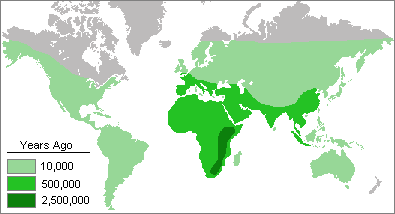In order to better understand culture, it is useful to closely examine its characteristics and their
ramifications. In this section of the tutorial, you will learn about the
specific advantages that culture gives our species. You will also learn
about culture's limitations and shortcomings.
Culture Is An Adaptive Mechanism
The first humans evolved in tropical and subtropical regions of Africa about 2.5 million years ago. Since then, we have successfully occupied all of the major geographic regions of the world, but our bodies have remained essentially those of warm climate animals. We cannot survive outside of the warmer regions of our planet without our cultural knowledge and technology. What made it possible for our ancestors to begin living in temperate and ultimately subarctic regions of the northern hemisphere after half a million years ago was the invention of efficient hunting skills, fire use, and, ultimately, clothing, warm housing, agriculture, and commerce. Culture has been a highly successful adaptive mechanism for our species. It has given us a major selective advantage in the competition for survival with other life forms. Culture has allowed the global human population to grow from less than 10 million people shortly after the end of the last ice age to more than 6.5 billion people today, a mere 10,000 years later. Culture has made us the most dangerous and the most destructive large animal on our planet. It is ironic that despite the power that culture has given us, we are totally dependent on it for survival. We need our cultural skills to stay alive.
|
|
|
Expanding human geographic
range into new environmental zones |
|
|
| Successful
cultural technology for adapting to very cold winter environments |
Over the last several hundred thousand years, we have developed new survival related cultural skills and technologies at a faster rate than natural selection could alter our bodies to adapt to the environmental challenges that confronted us. The fact that cultural evolution can occur faster than biological evolution has significantly modified the effect of natural selection on humans. One consequence of this has been that we have not developed thick fat layers and dense fur coats like polar bears in the cold regions because our culture provided the necessary warmth during winter times.
Culture is learned
Human infants come into the world with basic drives such as hunger and thirst, but they do not possess instinctive patterns of behavior to satisfy them. Likewise, they are without any cultural knowledge. However, they are genetically predisposed to rapidly learn language and other cultural traits. New born humans are amazing learning machines. Any normal baby can be placed into any family on earth and grow up to learn their culture and accept it as his or her own. Since culture is non-instinctive, we are not genetically programmed to learn a particular one.
|
|
|
|
North American
children |
|
Every human generation potentially can discover new things and invent better technologies. The new cultural skills and knowledge are added onto what was learned in previous generations. As a result, culture is cumulative. Due to this cumulative effect, most high school students today are now familiar with mathematical insights and solutions that ancient Greeks such as Archimedes and Pythagoras struggled their lives to discover.
Cultural evolution is due to the cumulative effect of culture. We now understand that the time between major cultural inventions has become steadily shorter, especially since the invention of agriculture 8,000-10,000 years ago. The progressively larger human population after that time was very likely both a consequence and a cause of accelerating culture growth. The more people there are, the more likely new ideas and information will accumulate. If those ideas result in a larger, more secure food supplies, the population will inevitably grow. In a sense, culture has been the human solution to surviving changing environments, but it has continuously compounded the problem by making it possible for more humans to stay alive. In other words, human cultural evolution can be seen as solving a problem that causes the same problem again and again. The ultimate cost of success of cultural technology has been a need to produce more and more food for more and more people.
|
Parallel Growth of the
Human Population and Cultural Technology |
|
|
The invention of agriculture made it possible for our ancestors to have a more controllable and, subsequently, dependable food supply. It also resulted in settling down in permanent communities. This in turn set the stage for further developments in technology and political organization. The inevitable result was more intensive agriculture, new kinds of social and political systems dominated by emerging elite classes, the first cities, and ultimately the industrial and information revolutions of modern times. City life brought with it the unexpected consequence of increased rates of contagious diseases. Large, dense populations of people make it much easier for viruses, bacteria, and other disease causing microorganisms to spread from host to host. As a result, most cities in the past were periodically devastated by epidemics.
 |
 |
|
| Agriculture based ancient
city (Thebes, Egypt) |
Modern post-industrial
city (New York) |
The rate of cultural evolution for many human societies during the last two centuries has been unprecedented. Today, major new technologies are invented every few years rather than once or twice a century or even less often, as was the case in the past. Likewise, there has been an astounding increase in the global human population. It is worth reflecting on the fact that there are people alive today who were born before cell phones, computers, televisions, radios, antibiotics, and even airplanes. These now elderly individuals have seen the human population double several times. The world that was familiar to them in their childhood is no longer here. It is as if they have moved to a new alien culture and society. Not surprisingly, they often have difficulty in accepting and adjusting to the change. The psychological distress and confusion that accompanies this has been referred to as future shock.
Cultures Change
|
|
| Tool of modern technology |
All cultural knowledge does not perpetually accumulate. At the same time that new cultural traits are added, some old ones are lost because they are no longer useful. For example, most city dwellers today do not have or need the skills required for survival in a wilderness. Most would very likely starve to death because they do not know how to acquire wild foods and survive the extremes of weather outdoors. What is more important in modern urban life are such things as the ability to drive a car, use a computer, and understand how to obtain food in a supermarket or restaurant.
The regular addition and subtraction of cultural traits results in culture change. All cultures change over time--none is static. However, the rate of change and the aspects of culture that change varies from society to society. For instance, people in Germany today generally seem eager to adopt new words from other languages, especially from American English, while many French people are resistant to it because of the threat of "corrupting" their own language. However, the French are just as eager as the Germans to adopt new technology.
|
|
|
North American
woman in a |
Change can occur as a result of both
invention within a society as well as the diffusion
![]() of cultural traits from one society to another. Predicting whether a
society will adopt new cultural traits or abandon others is complicated by the
fact that the various aspects of a culture are closely interwoven into a
complex pattern. Changing one trait will have an impact on other traits
because they are functionally interconnected. As a result, there
commonly is a resistance to major changes. For example, many men in
North America and Europe resisted the increase in economic and political
opportunities for women over the last century because of the far ranging
consequences. It inevitably changed the nature of marriage, the family,
and the lives of all men. It also significantly altered the workplace as
well as the legal system and the decisions made by governments.
of cultural traits from one society to another. Predicting whether a
society will adopt new cultural traits or abandon others is complicated by the
fact that the various aspects of a culture are closely interwoven into a
complex pattern. Changing one trait will have an impact on other traits
because they are functionally interconnected. As a result, there
commonly is a resistance to major changes. For example, many men in
North America and Europe resisted the increase in economic and political
opportunities for women over the last century because of the far ranging
consequences. It inevitably changed the nature of marriage, the family,
and the lives of all men. It also significantly altered the workplace as
well as the legal system and the decisions made by governments.
People Usually are not Aware of Their Culture
The way that we interact and do things in our everyday lives seems "natural" to us. We are unaware of our culture because we are so close to it and know it so well. For most people, it is as if their learned behavior was biologically inherited. It is usually only when they come into contact with people from another culture that they become aware that their patterns of behavior are not universal.
The common response in all societies
to other cultures is to judge them in terms of the values and customs of their
own familiar culture. This is ethnocentrism
![]() . Being fond of
your own way of life and condescending or even hostile toward other cultures is
normal for all people. Alien culture traits are often viewed as being
not just different but inferior, less sensible, and even "unnatural." For
example, European cultures strongly condemn other societies that practice
polygamy and the eating of dogs--behavior that Europeans generally consider
to be immoral and offensive. Likewise, many people in conservative Muslim societies,
such as Afghanistan and Saudi Arabia, consider European women highly immodest and immoral
for going out in public without being chaperoned by a male relative and
without their bodies covered from head to toe so as to prevent men from
looking at them. Ethnocentrism is not characteristic only of complex
modern societies. People in small, relatively isolated societies are
also ethnocentric in their views about outsiders.
. Being fond of
your own way of life and condescending or even hostile toward other cultures is
normal for all people. Alien culture traits are often viewed as being
not just different but inferior, less sensible, and even "unnatural." For
example, European cultures strongly condemn other societies that practice
polygamy and the eating of dogs--behavior that Europeans generally consider
to be immoral and offensive. Likewise, many people in conservative Muslim societies,
such as Afghanistan and Saudi Arabia, consider European women highly immodest and immoral
for going out in public without being chaperoned by a male relative and
without their bodies covered from head to toe so as to prevent men from
looking at them. Ethnocentrism is not characteristic only of complex
modern societies. People in small, relatively isolated societies are
also ethnocentric in their views about outsiders.
 |
Our ethnocentrism causes us
to be shocked and even disgusted at attitudes about other animals in different cultures. This North American woman considers her dog to be a close friend and essentially a member of her own family. In the Muslim world, dogs are generally considered to be dirty animals that are likely to be kicked if they get in the way. In some areas of Southeast Asia, dogs have multiple functions, including being a source of food for people. |
Our ethnocentrism can prevent us from
understanding and appreciating another culture. When anthropologists
study other societies, they need to suspend their own
ethnocentric judgments and adopt a cultural relativity approach.
That is, they try to learn about and interpret the various aspects of the culture
they are studying in reference to that culture rather than to the
anthropologist's own culture. This provides an understanding of how such practices as polygamy can function and even support other
cultural traditions. Without taking a cultural relativity approach, it
would otherwise be difficult, for example, to comprehend why women among the Masai
![]() cattle herding people of Kenya might
prefer to be one of several co-wives rather than have a
monogamous
cattle herding people of Kenya might
prefer to be one of several co-wives rather than have a
monogamous
![]() marriage.
marriage.
 |
|
Taking a cultural relativity approach is not only useful for anthropologists. It is a very useful tool for diplomats, businessmen, doctors, and any one else who needs to interact with people from other societies and even other subcultures within their own society. However, it can be emotionally difficult and uncomfortable at first to suspend one's own cultural values in these situations.
From an objective perspective, it can be seen that ethnocentrism has both positive and negative values for a society. The negative potential is obvious. Ethnocentrism results in prejudices about people from other cultures and the rejection of their "alien ways." When there is contact with people from other cultures, ethnocentrism can prevent open communication and result in misunderstanding and mistrust. This would be highly counterproductive for businessmen trying to negotiate a trade deal or even just neighbors trying to get along with each other. The positive aspect of ethnocentrism has to do with the protection that it can provide for a culture. By causing a rejection of the foods, customs, and perceptions of people in other cultures, it acts as a conservative force in preserving traditions of one's own culture. It can help maintain the separation and uniqueness of cultures.
We Do Not Know All of Our Own Culture
No one knows everything about his or her own culture. In all societies, there are bodies of specialized cultural knowledge that are gender specific--they are known to men but not women or vice versa. In many societies there are also bodies of knowledge that are limited largely to particular social classes, occupations, religious groups, or other special purpose associations.
Gender based skills, knowledge, and perceptions largely stem from the fact that boys and girls to some extent are treated differently from each other in all societies. While there may be considerable overlap in what they are taught, there are some things that are gender specific. In the Western World, for instance, it is more common to teach boys about the skills of combat and how machines work. Girls are more often exposed to the subtleties of social interaction and the use of clothing and makeup to communicate intentions. Not surprisingly, men are more likely to know how to fix their car or computer, while women generally are better at predicting the outcome of social interaction and make finer distinctions in fabric and color terms. You can test your own gender related cultural knowledge with the following pictures of relatively common items from North America:
 |
|
|
|
Do you think that this woman is wearing makeup? If so, what kinds of makeup is she using? Look closely and take your time. |
There are many professions in large-scale societies. Each one usually has its own terminology and specialized tools. Lawyers, medical doctors, soldiers, and other specialists use numerous technical terms in their professions. To make it even more obscure for outsiders, these professionals often use abbreviations to refer to their technical terms. For instance, orthopedic surgeons commonly refer to a particular kind of knee operation as ACL surgery. ACL stands for anterior cruciate ligament. Most people outside of the medical fields who have not had this surgery are unlikely to know where this ligament is and what it does, let alone know what the abbreviation means. You can test your knowledge of another common profession in North America with the following picture:
 |
Who is most likely to
use this tool? What is its function? |
Culture Gives Us a Range
of
Permissible Behavior Patterns
Cultures commonly allow a range of ways in which men can be men and women can be women. Culture also tells us how different activities should be conducted, such as how one should act as a husband, wife, parent, child, etc. These rules of permissible behavior are usually flexible to a degree--there are some alternatives rather than hard rules. In North America, for instance, culture tells us how we should dress based on our gender, but it allows us to dress in different ways in different situations in order to communicate varied messages and statuses. The clothing patterns of women in this society can be particularly rich and complex. Their clothing can be intentionally business-like, recreational, as well as sexually attractive, ambiguous, neutral, or even repulsive. North American women are generally more knowledgeable than men about the subtleties of using clothing and other adornment to communicate their intentions. The wide range of permissible ways of being a woman in North America today makes women somewhat unpredictable as individuals when others are trying to understand their intentions but do not fully comprehend the cultural patterns. It is particularly hard for men from other cultures to comprehend the subtle nuances. This at times can result in awkward or even dangerous situations. For instance, the easy friendliness and casual, somewhat revealing dress of young North American women in the summertime is sometimes interpreted by traditional Latin American and Middle Eastern men as a sexual invitation. What messages do the clothes and body language of the women in the pictures below communicate to you? How do you think they might be interpreted by members of the opposite gender and by people in other cultures? Do you think that the age of the observer might play a part in their interpretation?
 |
 |
The range of permissible ways of dressing and acting as a man or woman are often very limited in strictly fundamental Muslim, Jewish, Christian, and Hindu societies. In Afghanistan under the Taliban rule during the late 1990's, men were expected to wear traditional male clothing and were beaten or jailed by morality police for not having a full beard, playing or listening to music, or allowing female family members to go out in public unchaperoned. Women were similarly punished for being in public without wearing a plain loose outer gown that covered their face and entire body including their feet. They also were not allowed to go to school or to work outside of the home. To the surprise of Europeans and North Americans, many of these conservative cultural patterns did not disappear with the end of Taliban control. They are deeply ingrained in the Islamic tradition of Afghanistan and in the more conservative nations of the Middle East.
 |
Conservative Muslim women in the Middle East. They are fully covered for modesty in public and are being escorted by a male relative (Note:
women in some predominantly |
Cultures No Longer Exist in Isolation
 |
| Australian Aborigine
wearing European style clothes |
It is highly unlikely that there are any societies still existing in total isolation from the outside world. Even small, out of the way tribal societies are now being integrated to some extent into the global economy. That was not the case a few short generations ago. Some of the societies in the Highlands of New Guinea were unaware of anyone beyond their homeland until the arrival of European Australian miners in the 1930's. A few of the Indian tribes in the Upper Amazon Basin of South America remained unaware of the outside world until explorers entered their territories in the 1950's and 1960's. Members of these same New Guinean and Amazonian societies today buy clothes and household items produced by multinational corporations. They are developing a growing knowledge of other cultures through schools, radios, and even televisions and the Internet. As a result of this inevitable process, their languages and indigenous cultural patterns are being rapidly replaced. Virtually all societies are now acquiring cultural traits from the economically dominant societies of the world. The most influential of these dominant societies today are predominantly in North America and Western Europe. However, even these societies are rapidly adopting words, foods, and other cultural traits from all over the world.
Wade Davis: Dreams from endangered cultures--National Geographic anthropologist describes some
of the indigenous cultures being lost in our time. This link takes you to an external website. To return
here, you must click the "back" button on your browser program. (length = 22 mins, 5 secs)
The emergence of what is essentially a shared
global culture is not likely to result in the current major cultures
disappearing in the immediate future the same way many of the small indigenous ones
have. Language differences and ethnocentrism will very likely prevent
that from happening. There are powerful conflicting trends in the world today.
At the same time that many people are actively embracing
globalism
![]() ,
others are reviving
tribalism
,
others are reviving
tribalism
![]() . The break-up of the former empire of the Soviet
Union into largely ethnic based nations is an example of the latter.
Likewise, some of the nations in Africa whose boundaries were arbitrarily
created by Europeans during the colonial era are now experiencing periodic tribal wars
that may result in the creation of more ethnically based countries.
. The break-up of the former empire of the Soviet
Union into largely ethnic based nations is an example of the latter.
Likewise, some of the nations in Africa whose boundaries were arbitrarily
created by Europeans during the colonial era are now experiencing periodic tribal wars
that may result in the creation of more ethnically based countries.







